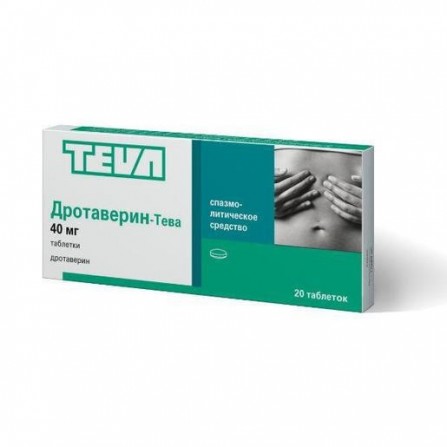Drotaverine Teva pills 40mg N20
Condition: New product
1000 Items
Rating:
Be the first to write a review!

More info
Active ingredients
Drotaverine
Release form
Pills
Composition
1 tablet contains: the active substance Drotaverine hydrochloride 40.00 mg; excipients: lactose monohydrate 67.00 mg; Povidone-K25 4.00 mg; microcrystalline cellulose 21.00 mg; croscarmellose sodium 5.00 mg; magnesium stearate 3.00 mg.
Pharmacological effect
Drotaverine is an isoquinoline derivative that has a spasmolytic effect on smooth muscle by inhibiting the enzyme phosphodiesterase 4 (PDE-4). Inhibition of the enzyme PDE-4 leads to an increase in the concentration of cyclic adenosine monophosphate (cAMP), which inactivates the light chain of myosin kinase (MLCK), which, in turn, leads to the relaxation of smooth muscles. 3 and PDE-5. Apparently, PDE-4 is functionally very important for reducing the contractility of smooth muscles, therefore selective PDE-4 inhibitors can be effective in treating hyperkinetic diseases and diseases associated with spastic conditions of the gastrointestinal tract (GIT). Hydrating enzyme cAMP in cells of the smooth muscles of the myocardium and blood vessels, is mainly an isoenzyme PDE-3, which explains the high efficacy of Drotaverine as an antispasmodic in the absence of a pronounced effect on the cardiovascular system and entail a grave cardiovascular undesired reaktsiy.Drotaverin effective spasm of smooth muscle as neural and muscle etiology. Regardless of the type of vegetative innervation, drotaverine acts on the smooth muscles of the gastrointestinal tract, biliary tract, as well as the urinary and vascular systems. Thanks to the vasodilating action, drotaverine improves the blood supply to the tissues.
Pharmacokinetics
Absorption and distributionWith ingestion and parenteral administration, drotaverine is rapidly and completely absorbed. The maximum plasma concentration (Cmax) is reached within 45-60 minutes. It binds to plasma proteins (alpha albumin, alpha and beta globulins). Metabolism and excretion Metabolized in the liver. The elimination half-life (T1 / 2) is 16-22 hours. After 72 hours, Drotaverine is eliminated from the body mainly as metabolites, 50% by the kidneys, 30% through the intestines.
Indications
- Spasms of smooth muscles associated with diseases of the liver and biliary tract: cholelithiasis, cholecystitis, pericholecystitis, cholangitis, papillitis; - spasms of smooth muscles of the urinary system: urolithiasis, pyelitis, cystitis, tenesmus of the bladder. Muscles of the gastrointestinal tract: peptic ulcer of the stomach and duodenum, gastritis, spasms of the cardia and pylorus, enteritis, colitis, accompanied by constipation and flatulence; - tensor headache; - dysmenorrhea.
Contraindications
Hypersensitivity to Drotaverine or to any of the components of the drug; severe renal failure; severe liver failure (Child-Pugh class C); severe heart failure (low cardiac output syndrome); children up to 6 years; breastfeeding period; lactose intolerance, lactase deficiency, glucose-galactose malabsorption syndrome.
Use during pregnancy and lactation
Data on drug overdose with Drotaverin-Teva are not available. Symptoms of overdose can be cardiac arrhythmias and conduction disorders (including complete blockade of the bundle of the His bundle), cardiac arrest, or even death. Treatment: gastric lavage, symptomatic therapy.
Dosage and administration
Inside, drinking plenty of fluids. The recommended daily dose for adults is 120-240 mg (in 2-3 doses). For children aged 6 to 12 years, the maximum daily dose is 80 mg divided into 2 doses; for children over 12 years old, the maximum daily dose is 160 mg divided into 2-4 doses. The recommended duration of treatment without consulting a doctor is 1-2 days.
Side effects
Precautionary measures
Overdose
Interaction with other drugs
special instructions
Side effects are classified according to the following frequency: very often - at least 10%; often not less than 1%, but less than 10%; infrequently - not less than 0.1%, but less than 1%; rarely - not less than 0.01%, but less than 0.1%; very rarely (including individual messages) - less than 0.01%; frequency unknown - not enough data to estimate the frequency of the phenomenon in the population. From the gastrointestinal tract: rarely - nausea, constipation. From the central nervous system: rarely - headache, dizziness, insomnia. From the side of the cardiovascular system: rarely - heart palpitations; very rarely - lowering blood pressure.



